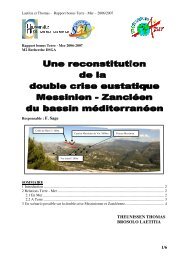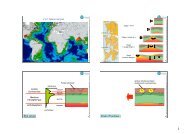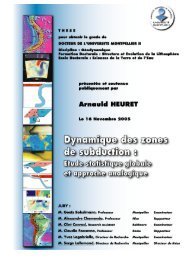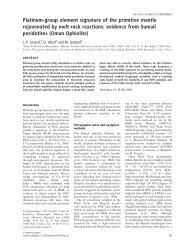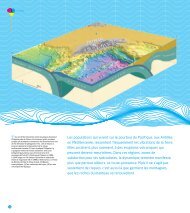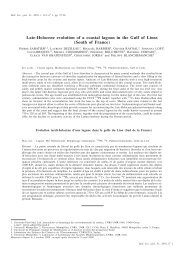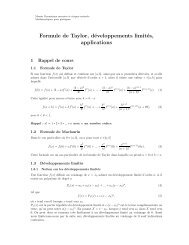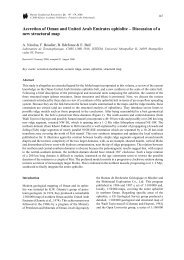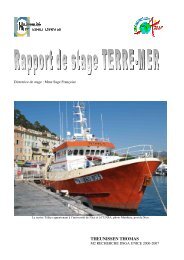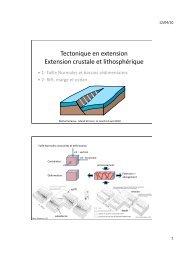Géochronologie U-Pb par ablation laser et ICP-MS (LA-ICP-MS ...
Géochronologie U-Pb par ablation laser et ICP-MS (LA-ICP-MS ...
Géochronologie U-Pb par ablation laser et ICP-MS (LA-ICP-MS ...
You also want an ePaper? Increase the reach of your titles
YUMPU automatically turns print PDFs into web optimized ePapers that Google loves.
Lithos 96 (2007) 325–352<br />
www.elsevier.com/locate/lithos<br />
Micro-scale element migration during eclogitisation in the Bergen<br />
arcs (Norway): A case study on the role of fluids and deformation<br />
J. Schneider a,b, ⁎ , D. Bosch a , P. Monié c , O. Bruguier d<br />
a Laboratoire de Tectonophysique, CNRS UMR 5568, Université Montpellier II, Place E. Bataillon, 34095 Montpellier Cedex 05, France<br />
b Institute of Earth Sciences, Academia Sinica, 128 Academia Road, Sec.2, Nangang, Taipei 115 29, Taiwan, R.O.C.<br />
c Laboratoire de Dynamique de la Lithosphère, CNRS UMR 5573, Université Montpellier II, Place E. Bataillon,<br />
34095 Montpellier Cedex O5, France<br />
d Service <strong>ICP</strong><strong>MS</strong>, ISTEEM, Université Montpellier II, Place E. Bataillon, 34095 Montpellier Cedex 05, France<br />
Received 19 March 2006; accepted 25 October 2006<br />
Available online 8 December 2006<br />
Abstract<br />
Understanding chemical element mobility during high-pressure m<strong>et</strong>amorphism is <strong>par</strong>amount to the knowledge of the<br />
transformations occurring during the course of eclogite-facies m<strong>et</strong>amorphism. In <strong>par</strong>ticular, the role of deformation and fluid<br />
circulation appear essential. In order to b<strong>et</strong>ter decipher this role, we investigated two eclogite-facies samples from the Lindås Nappe<br />
in the Bergen arcs (Norwegian Caledonides), which are related to a fluid/deformation m<strong>et</strong>amorphic event. This study, based on<br />
d<strong>et</strong>ailed microtextural investigations, coupled with major and trace element analyses, either in situ EMPA and <strong>LA</strong>-<strong>ICP</strong>-<strong>MS</strong> or by<br />
conventional <strong>ICP</strong>-<strong>MS</strong> nebulisation on mineral fractions, illustrates the complexity of chemical reactions accompanying the eclogiteand<br />
amphibolite-facies m<strong>et</strong>amorphism. A single eclogite-facies mineral species two eclogite-facies (i.e. phengite and epidote)<br />
depicts various chemical features depending on its textural location at thin-section scale. The correlation with the mineralogical<br />
reaction occurring in each textural site demonstrates that the compositional variations are inherited from the precursor minerals.<br />
Thus, the composition of eclogite-facies minerals is locally controlled by the composition of few hundred-micron domains. On the<br />
contrary, alteration phases of the amphibolite facies (symplectite and calcic amphibole) display clear enrichment in LILE, <strong>Pb</strong>, Sr and<br />
LREE com<strong>par</strong>ed to their precursor minerals (omphacite and garn<strong>et</strong>). This supports that the transport of elements at hand-sample scale<br />
was enhanced during the r<strong>et</strong>rogression and elements were efficiently delocalised from one textural site to another.<br />
The contrasting behaviour of element mobility b<strong>et</strong>ween peak eclogite-facies m<strong>et</strong>amorphism and r<strong>et</strong>rogression can be explained<br />
in terms of rate processes and fluid/deformation activity. During eclogitisation, deformation allows the formation of textural and<br />
mineralogical microdomains. Contemporaneously the fluid circulation favours the development of h<strong>et</strong>erogeneities by transport of<br />
elements in excess towards areas protected from deformation where phengite-bearing quartz lenses crystallise. This, tog<strong>et</strong>her with<br />
the very fast recrystallisation of eclogite-facies minerals, results in a h<strong>et</strong>erogeneous redistribution of elements at sample scale and in<br />
a chemical disequilibrium b<strong>et</strong>ween different microdomains of hundred-micron size. During r<strong>et</strong>rogression in the amphibolite facies,<br />
coeval with long-term ductile deformation, the fluids act as an efficient vector to redistribute the elements from a given textural site<br />
to another and, thus, allow to reach, at hand-sample scale, a new chemical equilibrium b<strong>et</strong>ween the different crystallising phases.<br />
© 2006 Elsevier B.V. All rights reserved.<br />
Keywords: Eclogite; <strong>LA</strong>-<strong>ICP</strong>-<strong>MS</strong>; Microdomains; Element mobility; Amphibolite-facies m<strong>et</strong>amorphism; Fluid; REE<br />
⁎ Corresponding author. Institute of Earth Sciences, Academia Sinica, 128 Academia Road, Sec.2, Nangang, Taipei 115 29, Taiwan, R.O.C.<br />
Tel.: +886 2 2783 9910x618; fax: +886 2 2783 9871.<br />
E-mail address: juliesch@earth.sinica.edu.tw (J. Schneider).<br />
0024-4937/$ - see front matter © 2006 Elsevier B.V. All rights reserved.<br />
doi:10.1016/j.lithos.2006.10.001



